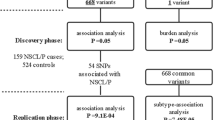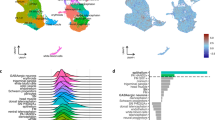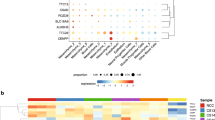Abstract
Recent genome-wide association studies have identified single nucleotide polymorphisms (SNPs) associated with non-syndromic cleft lip with or without cleft palate (NSCL/P), and other previous studies showed distinctly differing facial distance measurements when comparing unaffected relatives of NSCL/P patients with normal controls. Here, we test the hypothesis that genetic loci involved in NSCL/P also influence normal variation in facial morphology. We tested 11 SNPs from 10 genomic regions previously showing replicated evidence of association with NSCL/P for association with normal variation of nose width and bizygomatic distance in two cohorts from Germany (N=529) and the Netherlands (N=2497). The two most significant associations found were between nose width and SNP rs1258763 near the GREM1 gene in the German cohort (P=6 × 10−4), and between bizygomatic distance and SNP rs987525 at 8q24.21 near the CCDC26 gene (P=0.017) in the Dutch sample. A genetic prediction model explained 2% of phenotype variation in nose width in the German and 0.5% of bizygomatic distance variation in the Dutch cohort. Although preliminary, our data provide a first link between genetic loci involved in a pathological facial trait such as NSCL/P and variation of normal facial morphology. Moreover, we present a first approach for understanding the genetic basis of human facial appearance, a highly intriguing trait with implications on clinical practice, clinical genetics, forensic intelligence, social interactions and personal identity.
Similar content being viewed by others
Log in or create a free account to read this content
Gain free access to this article, as well as selected content from this journal and more on nature.com
or
References
Boehringer S, Vollmar T, Tasse C et al: Syndrome identification based on 2D analysis software. Eur J Hum Genet 2006; 14: 1082–1089.
Kayser M, Schneider PM : DNA-based prediction of human externally visible characteristics in forensics: motivations, scientific challenges, and ethical considerations. Forensic Sci Int Genet 2009; 3: 154–161.
Kohn LAP : The role of genetics in craniofacial morphology and growth. Ann Rev Anthropol 1991; 20: 261–278.
Winter RM : What's in a face? Nat Genet 1996; 12: 124–129.
Mossey PA, Little J, Munger RG, Dixon MJ, Shaw WC : Cleft lip and palate. Lancet 2009; 374: 1773–1785.
Mills LF, Niswander JD, Mazaheri M, Brunelle JA : Minor oral and facial defects in relatives of oral cleft patients. Angle Orthod 1968; 38: 199–204.
Weinberg SM, Neiswanger K, Richtsmeier JT et al: Three-dimensional morphometric analysis of craniofacial shape in the unaffected relatives of individuals with nonsyndromic orofacial clefts: a possible marker for genetic susceptibility. Am J Med Genet A 2008; 146A: 409–420.
Weinberg SM, Maher BS, Marazita ML : Parental craniofacial morphology in cleft lip with or without cleft palate as determined by cephalometry: a meta-analysis. Orthod Craniofac Res 2006; 9: 18–30.
Hinrichsen KV : Slides On Human Embryology. Heidelberg: Springer, Heidelberg, 1986.
Wong FK, Hagg U : An update on the aetiology of orofacial clefts. Hong Kong Med J 2004; 10: 331–336.
Rahimov F, Marazita ML, Visel A et al: Disruption of an AP-2alpha binding site in an IRF6 enhancer is associated with cleft lip. Nat Genet 2008; 40: 1341–1347.
Birnbaum S, Ludwig KU, Reutter H et al: Key susceptibility locus for nonsyndromic cleft lip with or without cleft palate on chromosome 8q24. Nat Genet 2009; 41: 473–477.
Mangold E, Ludwig KU, Birnbaum S et al: Genome-wide association study identifies two susceptibility loci for nonsyndromic cleft lip with or without cleft palate. Nat Genet 2010; 42: 24–26.
Beaty TH, Murray JC, Marazita ML et al: A genome-wide association study of cleft lip with and without cleft palate identifies risk variants near MAFB and ABCA4. Nat Genet 2010; 42: 525–529.
Vollmar T, Maus B, Wurtz RP et al: Impact of geometry and viewing angle on classification accuracy of 2D based analysis of dysmorphic faces. Eur J Med Genet 2008; 51: 44–53.
Hofman A, Breteler MMB, van Duijn CM et al: The Rotterdam Study: 2010 objectives and design update. Eur J Epidemiol 2009; 24: 553–572.
Vernooij MW, de Groot M, van der Lugt A et al: White matter atrophy and lesion formation explain the loss of structural integrity of white matter in aging. Neuroimage 2008; 43: 470–477.
Hill DL, Batchelor PG, Holden M, Hawkes DJ : Medical image registration. Phys Med Biol 2001; 46: R1–R45.
Klein S, Staring M, Murphy K, Viergever MA, Pluim JPW : elastix: a toolbox for intensity-based medical image registration. IEEE Trans Med Imaging 2010; 29: 196–205.
Liu F, van Duijn K, Vingerling JR et al: Eye color and the prediction of complex phenotypes from genotypes. Curr. Biol 2009; 19: R192–R193.
Levy D, Ehret GB, Rice K et al: Genome-wide association study of blood pressure and hypertension. Nat Genet 2009; 41: 677–687.
Weinberg SM, Naidoo SD, Bardi KM et al: Face shape of unaffected parents with cleft affected offspring: combining three-dimensional surface imaging and geometric morphometrics. Orthod Craniofac Res 2009; 12: 271–281.
Shrestha I, Ohtsuki T, Takahashi T, Nomura E, Kohriyama T, Matsumoto M : Diagonal ear-lobe crease is correlated with atherosclerotic changes in carotid arteries. Circ J 2009; 73: 1945–1949.
Wyszynski DF : Cleft lip and palate: from origin to treatment. Oxford: Oxford University Press, Oxford, 2002.
Weedon MN, Lango H, Lindgren CM et al: Genome-wide association analysis identifies 20 loci that influence adult height. Nat Genet 2008; 40: 575–583.
Branicki W, Liu F, van Duijn K et al: Model-based prediction of human hair color using DNA variants. Hum Genet 2011; 129: 443–454.
Acknowledgements
This study was supported in parts by IFORES Grant 107-05860, Universitätsklinikum Essen, DFG grants BO 1955/2-3 and WU 314/6-2, the Netherlands Forensic Institute, the Netherlands Genomics Initiative (NGI)/Netherlands Organization for Scientific Research (NWO) within the framework of the Forensic Genomics Consortium Netherlands (FGCN). The generation and management of genome-wide genotype data for the Rotterdam Study were supported by an NWO investments grant (nr. 175.010.2005.011, 911-03-012). MRI analysis was in part performed on supercomputer facilities sponsored by the Stichting Nationale Computerfaciliteiten (National Computing Facilities Foundation, NCF) with financial support from NWO. The Rotterdam Study received additional support by the Netherlands Genomics Initiative (NGI) and Netherlands Organization for Scientific Research (NWO) (nr. 050-060-810), the Research Institute for Diseases in the Elderly (RIDE) (nr. 014-93-015), and is funded by the Erasmus University Medical Center, the Erasmus University Rotterdam, the Netherlands Organization for the Health Research and Development (ZonMw), the RIDE, the Ministry of Education, Culture and Science of the Netherlands, the Ministry for Health, Welfare and Sports of the Netherlands, the European Commission (DG XII) and the Municipality of Rotterdam.
Author information
Authors and Affiliations
Corresponding author
Ethics declarations
Competing interests
The authors declare no conflict of interest.
Additional information
Supplementary Information accompanies the paper on European Journal of Human Genetics website
Supplementary information
Rights and permissions
About this article
Cite this article
Boehringer, S., van der Lijn, F., Liu, F. et al. Genetic determination of human facial morphology: links between cleft-lips and normal variation. Eur J Hum Genet 19, 1192–1197 (2011). https://doi.org/10.1038/ejhg.2011.110
Received:
Revised:
Accepted:
Published:
Issue date:
DOI: https://doi.org/10.1038/ejhg.2011.110
Keywords
This article is cited by
-
Classification of early age facial growth pattern and identification of the genetic basis in two Korean populations
Scientific Reports (2022)
-
The heritability of vocal tract structures estimated from structural MRI in a large cohort of Dutch twins
Human Genetics (2022)
-
Association between the FGFR1 rs13317 single nucleotide polymorphism and orbitale-nasion depth based on cephalometric images
Journal of Human Genetics (2018)
-
Ensemble landmarking of 3D facial surface scans
Scientific Reports (2018)
-
Nucleotide Variants of the BH4 Biosynthesis Pathway Gene GCH1 and the Risk of Orofacial Clefts
Molecular Neurobiology (2016)



